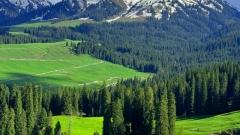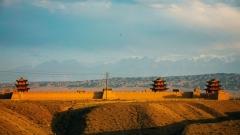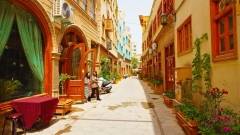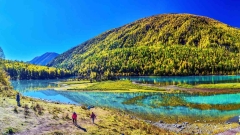Xinjiang, located in the far northwest of China, is a region where diverse cultures, religions, and histories meet. Among them, Islam has played a central role for over a thousand years, shaping the art, architecture, and daily life of its people. From the grand mosques of Kashgar and Turpan to the vibrant bazaars echoing with the call to prayer, Islam in Xinjiang is not only a religion—it’s a living tradition deeply woven into the fabric of the Silk Road.
The History of Islam in Xinjiang
Islam first arrived in Xinjiang during the 8th and 9th centuries, carried by Arab and Persian traders who traveled along the ancient Silk Road. The religion gradually spread among the local Uighur, Kazakh, Hui, and Tajik communities.
By the 10th century, under the Kara-Khanid Khanate, Islam became the dominant faith in the region. Kashgar emerged as a key Islamic cultural center, and scholars, poets, and architects flourished under its influence.
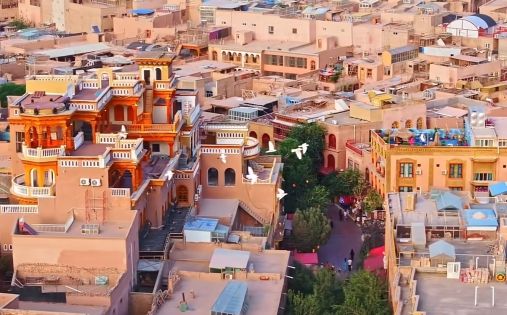
Kashgar
Over centuries, Xinjiang’s strategic location allowed Islamic culture to blend with Chinese, Persian, and Central Asian elements, creating a distinct form of Islam that is both local and global in its expression.
Iconic Mosques Across Xinjiang
(1) Id Kah Mosque – The Heart of Kashgar
The Id Kah Mosque, built in 1442, is the largest mosque in China, capable of holding up to 20,000 worshippers.
Located in Kashgar’s old town, the mosque is an architectural masterpiece of yellow bricks, arched gates, and carved woodwork. The prayer hall and courtyard reflect classic Islamic symmetry and balance.
Every Friday, the mosque becomes a gathering place for the faithful, and during major Islamic festivals, the surrounding square comes alive with prayers, songs, and celebrations.
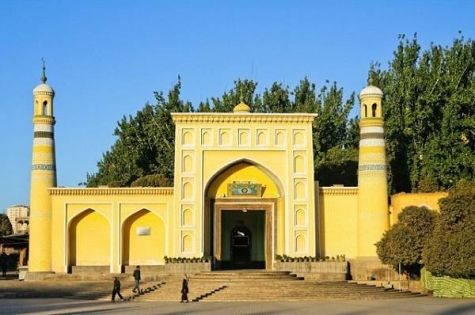
Id Kah Mosque
(2) Emin Minaret Mosque – The Symbol of Turpan
In Turpan, the Emin Minaret Mosque (Su Gong Ta) stands as one of Xinjiang’s most photographed landmarks. Built in 1777, its 40-meter-tall minaret—the tallest in China—is made entirely of sun-dried bricks arranged in geometric patterns.
The design reflects both Uighur craftsmanship and Central Asian influences, blending local clay architecture with Islamic motifs. It remains a powerful symbol of faith and resilience in Turpan’s desert landscape.
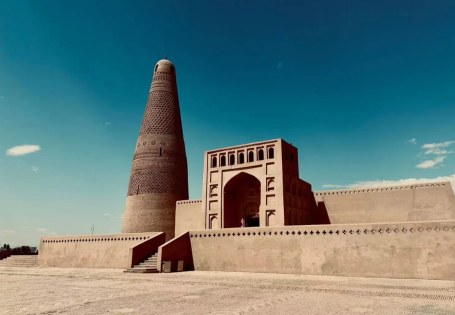
Emin Minaret Mosque
(3) Afaq Khoja Mausoleum – The Sacred Tomb of Kashgar
Also known as the Fragrant Concubine’s Tomb, this complex is not just a mausoleum but a revered pilgrimage site.
Built in the 17th century, it features turquoise domes, floral tiles, and ornate wooden doors—an extraordinary example of Islamic art along the Silk Road. Local Muslims visit the site to honor Afaq Khoja, a respected Sufi master, and his family.
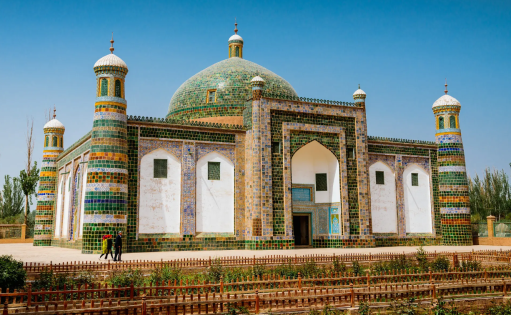
Afaq Khoja Mausoleum
The Practice of Faith and Daily Life
Islam in Xinjiang is more than worship—it is a way of life.
In Uighur communities, daily prayer, fasting during Ramadan, and attending Friday congregations are central to religious practice. Families gather to read the Quran and teach children about faith from an early age.
Dietary traditions are also guided by Islamic law: halal food dominates local cuisine. Dishes such as lamb kebabs, polo (rice pilaf), samsa (baked dumplings), and naan bread are staples found in every market.
Before every meal, a simple prayer is said, and hospitality is considered a sacred duty—guests are always welcomed with tea and bread.
Festivals and Cultural Celebrations
Eid al-Fitr (Rozi Heyt)
At the end of Ramadan, Uighur Muslims celebrate Eid al-Fitr, known locally as Rozi Heyt. It’s a time for communal prayers, charity, family visits, and sharing festive dishes. Streets and bazaars fill with laughter, music, and colorful clothing as people greet each other with joy.
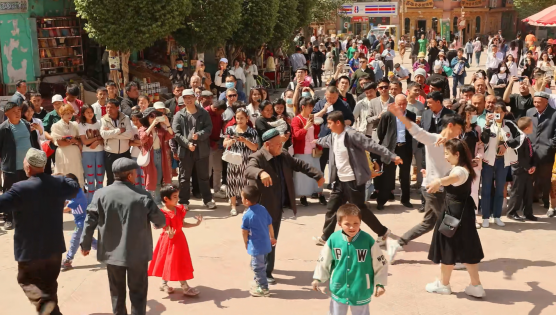
Eid al-Adha (Kurban Heyt)
Another major festival is Eid al-Adha, or Kurban Heyt, commemorating the story of Abraham’s devotion. Families sacrifice livestock—usually sheep—and share the meat with relatives, friends, and the poor.
In villages and cities alike, these festivals strengthen community bonds and spiritual devotion that have lasted for generations.
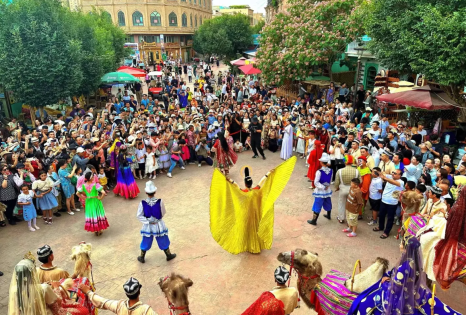
Islamic Architecture and Art in Xinjiang
Xinjiang’s mosques, mausoleums, and homes showcase a blend of Islamic, Persian, and Central Asian design traditions.
Common features include:
-
Domes and Arches: Symbolizing the heavens and unity of faith.
-
Calligraphy: Arabic verses from the Quran adorn walls and gateways.
-
Geometric Patterns: Reflecting harmony, balance, and the infinite nature of God.
-
Carved Woodwork and Tilework: Especially visible in Kashgar and Hotan, where artisans preserve centuries-old techniques.
Even in modern cities like Urumqi, new mosques continue to incorporate these timeless designs, showing how tradition adapts within contemporary life.
The Role of Islam in Local Identity
For many Uighurs, Kazakhs, and Hui people, Islam forms the foundation of cultural identity.
It influences music, clothing, family values, and moral principles. The daily adhan (call to prayer) echoing across the cities and oases is a reminder of community and continuity.
The faith also shapes social customs—from weddings that feature Quranic blessings to funerals marked by collective prayers. Even markets and crafts reflect spiritual roots, as many traders and artisans view their work as part of serving God and community.
Visiting Xinjiang’s Islamic Heritage with China Dragon Travel
For travelers, exploring Xinjiang’s Islamic heritage is a journey through history, art, and devotion. The combination of ancient mosques, lively bazaars, and warm hospitality makes it one of the most rewarding cultural experiences in China.
At China Dragon Travel, we offer carefully curated tours to Kashgar, Turpan, Hotan, and Urumqi, highlighting both famous landmarks and hidden gems. Our local guides share stories of faith, architecture, and daily life that reveal the living heart of Islam in Xinjiang.
Whether you want to photograph the golden minarets at sunset, walk through Kashgar’s old alleys, or taste authentic halal cuisine, we make your journey smooth, safe, and deeply insightful.
Conclusion
Islam in Xinjiang is a story written over a thousand years—of faith carried by Silk Road travelers, of communities bound by devotion, and of art that bridges worlds.
From the call to prayer echoing through Kashgar to the quiet dignity of worshippers in Turpan, Xinjiang’s Islamic culture is a reminder of how belief and beauty can thrive together.
Visiting this land is not just a trip—it’s a journey into the living soul of the Silk Road.



